I've described a few times (most recently when introducing Cargo Convoys) how Cogmind's world is divided into two primary types of maps: main areas and branches. There is technically a third category serving special purposes, one that after many years is once again growing as part of Beta 11. This other category is what I call "maps between maps," essentially much smaller maps forming optional bridges between the regular maps.
In its first year of Alpha builds Cogmind gained two such varieties of what we could call "intermaps," in the form of Waste and Garrisons. Waste is reached via Chute Traps that suck robots down into a dangerous but potentially useful disposal area, looping back out to another area of the Factory at the same depth, and Garrisons are a primary source of combat bots that you can chose to proactively infiltrate for various reasons. Waste maps have not been explicitly covered on the blog before, but Garrison design was discussed at length. Today we'll be covering a new type of intermap, the DSF.
![]()
The sample world map I put together earlier this year, now with DSFs and specifically highlighting all intermaps (redacted-level spoilers have been edited out) (full size here).
Intermaps share a number of characteristics that differentiate them from most other maps:
- Access from multiple depths: Intermaps of each type can always be found at more than one depth, so even if Cogmind doesn't visit them at a given depth, there are more chances to encounter and/or take advantage of them later.
- Numerous access points: Maps containing links to intermaps usually have multiple points from which to access them.
- Unique access methods: Intermaps are not entered via the usual openly available stairs or doors, and instead each have their own special types of entrances.
- Small interiors: The majority of regular Cogmind maps are fairly large, with main maps containing an average of 16,000 open cells, and branch maps around 4,000, but intermaps have only about 1,000 open cells.
- Strong theme: Intermaps are tightly designed around their own unique mechanics and theme.
- Optional: For the most part intermaps are entirely optional pathways (except being caught off guard by a chute, although some players opt to jump down known chutes as well).
- Strategically meaningful: These special maps offer unique challenges for specific benefits, and choosing to visit them can be a part of short- or long-term plans. Intermaps are also the only way to loop back to another variant of the current main map, which sometimes factors into strategies as well.
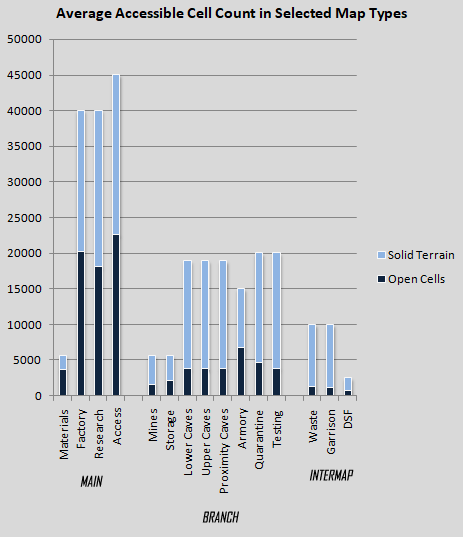
Comparing the total accessible area between main maps, select branch maps, and intermaps.
The closest common analogy for these maps to be found in other roguelikes is the concept of "vaults," or small thematic areas often with some sort of risk-reward mechanic or otherwise challenge or cost for access, though in cases where these are presented as actual separate maps (rather than contiguously embedded within larger maps as I've discussed with prefabs), one important difference is that vaults would generally lead back to the same map and location from where they were entered, i.e. just going back out the door or some other portal. This is not something Cogmind's intermaps can do because by design backtracking is not possible--leaving a map always pushes the player upwards or sideways on the world map to a completely new area, as seen in the sample world map connections above.

DCSS contains "portal vaults" (aka mini-branches or sub-branches), like this sewer entrance. See portals on the DCSS wiki, and info about Treasure Troves; you can also browse many portal vault sample layouts and content in the source here.
Distributed Storage Facility
"DSF" have been in Cogmind lore since the very first release, and were actually one of the earliest pieces of background lore, just a bit of world building in that it describes an aspect of the Complex that was not otherwise represented in game
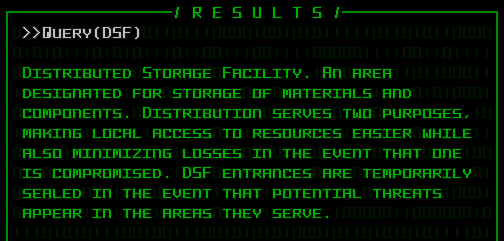
The latest iteration of the DSF lore entry hacked from a Terminal.
Worldbuilding generally calls for having a larger unrealized amount of content which is still at least referenced throughout the game, and Cogmind has always had a fair bit of that, though this sort of content also tends to be ripe with ideas for future features, or at least suggests where new playable content might want to emerge in a way that fits well with what already exists. So six years later, here we are with the real deal :)
In the past players had speculated that the Storage map might be an example of a DSF, which could indeed have been one explanation (no need to provide all the details when players can do a great--and better--job of filling these in on their own!), though the new official implementation aligns better with its stated intent, and Storage shall remain just a unique branch map by comparison. Storage and DSFs do, however, share a color theme.
Originally I wasn't planning on adding DSFs in Beta 11 (or ever, necessarily), but the opportunity presented itself when I needed a way to offer some form of guaranteed access to Authchips as part of the fabrication overhaul. So this really was an example of taking advantage of the existing lore and bringing it to life, expanding upon it, in order to meet other design needs. Of course if that's all it was for this might seem like overkill (adding a whole new map type?!), but I felt there was plenty of room to play with here for it to become an interesting strategic option, regardless of tie-ins to the fabrication system.
So let's look at how you get into this place, and what you might find there.
DSF Access
All Factory and Research maps have a number of DSF entrances, special-purpose Terminals that control an adjacent access point, similar to how Garrisons work. These locations have a unique look to them, a simple Terminal adjacent to an open cell where the door appears once unlocked via the Terminal, and surrounded on three sides by reinforced walls.
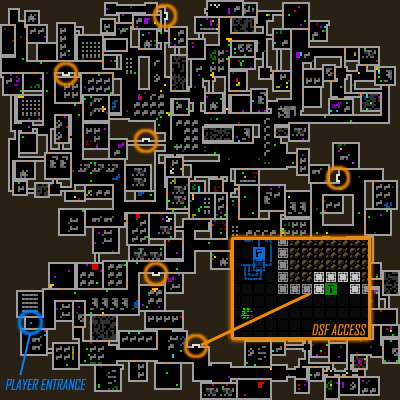
Sample Factory map layout highlighting all DSF Access locations, including an up-close look at the small prefab's appearance. The space adjacent to the 'T' is where the door appears.
Although there are enough access points that the chance to eventually spot one at some point on each map is quite high (that they're placed in corridors rather than inside rooms further increases this chance), the desired number here is mainly taking into account the fact that any which aren't somewhat near the player's entrance are unlikely to be accessible. The reason is due to a DSF-specific mechanic whereby all of the DSF entrances are permanently locked (as far as the player's time on the map is concerned) as soon as any hostiles are spotted. So to actually get inside one, the player must do so without being spotted by anything on the lookout for enemies of the Complex.
Even though DSFs were added to the game as a guaranteed method of obtaining Authchips, as I emphasized again in the recent fabrication article Cogmind's philosophy focuses more on adapting to what you find rather than having high control over predetermining your build, so although the Authchips themselves are guaranteed consistent rewards inside, the ability to access a DSF at all is the less consistent part of the equation :P
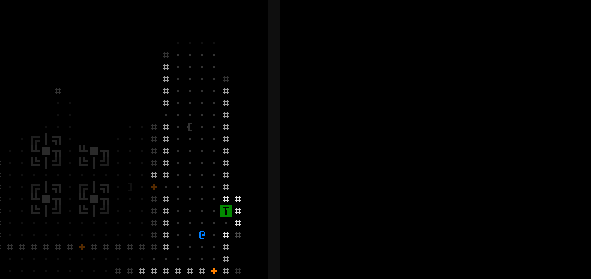
Opening a DSF via its Terminal.
To facilitate locating the nearest DSF, among the other usual possibilities there is also a new non-RIF Hauler hack that anyone with a Datajack can perform: find_dsf. The result of the hack takes advantage of the new map comments system, adding an automated comment marketing that particular Terminal for what it is.
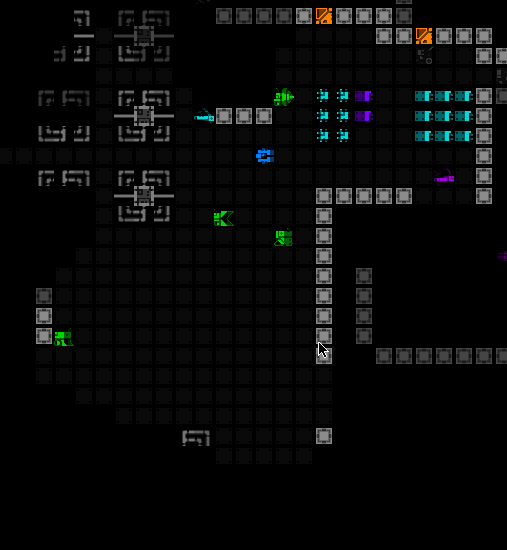
Hacking a Hauler to find the nearest DSF. Here you can also see the difference in color scheme for a map comment added automatically as opposed to manually by the player.
There is a global message when anything hostile is discovered on the current map and DSF lockdown is engaged (technically this doesn't have to be the player, but the player is the most likely to trigger it first), after which attempting to open any DSF will simply report that it's in lockdown mode.
Layout and Defenses
DSF map generation is similar to Garrisons in that it is based on quadrant prefabs, albeit simpler overall since there are no variations--each quadrant is either present or it isn't, and there must be at least two of them (one to hold the entrance and another for the exit).
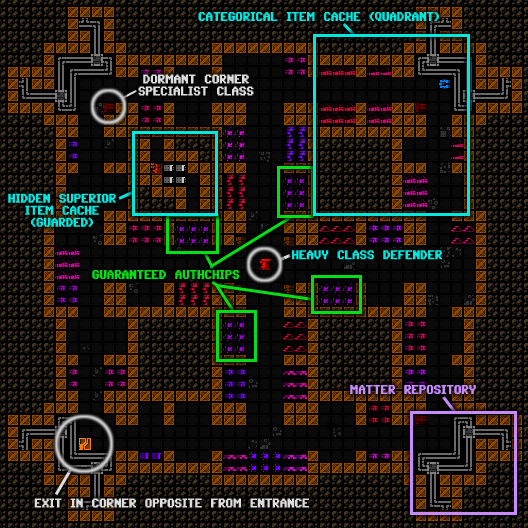
A full-sized four-quadrant DSF with its major features annotated.
There are quite a lot of good items to steal from a DSF, with four sections of Authchips around the center, two to four quadrants each with their own random theme (e.g. weapons, devices, traps...), and main corridors lined with random parts. Each quadrant also has a chance to include a hidden (but sometimes guarded) area behind its walls containing extremely good parts, and the Matter Repositories can also be damaged to recover a lot of Matter if necessary.
The primary defensive feature is the Heavy stationed at the center, around which the entire DSF layout was planned. Its sensor range covers almost the entire map (except the corners), and reaching the exit always requires passing through its visual range, so it's necessary to have a way to deal with this bot. Each corner also has a chance to contain a dormant Specialist. As usual the Heavy can call in reinforcements, and an infiltrated DSF will eventually also be subject to additional patrols, thus limiting the amount of time available to freely loot the area.
Destroying enough robots within a DSF triggers another emergency defensive measure, "rapid sterilization," or a quicker version of the sterilization system found in other parts of Complex 0b10 which gradually raises the ambient heat until no robots can survive. This offers another optional strategy to afford more time for looting since with enough cooling Cogmind can survive longer than other bots.
DSF are generally predictable as described above, and though the types of items found within can vary greatly (aside from the Authchips), there are so many of them that stashes will usually have at least something useful for most builds. But it's always nice to throw in a little more extreme variety for fun, so there are a number of possible DSF events that occur more rarely (without removing the chance to loot).
Routing
In most cases leaving a DSF will exit to the next higher depth, although there is a small chance it instead leads directly into a Garrison, to throw a little wrench into the best laid plans, for fun and excitement.
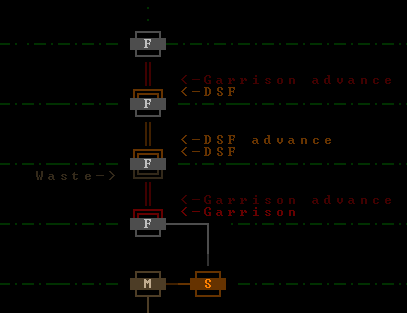
World map UI mockup reflecting intermap-related routes.
There are definitely more ideas that could later become new types of maps between maps (much longer-lived plans than the spontaneous DSF :P), and while I'm not sure how likely it is to happen, I'd also like to do experiments with small maps that can return the player to the same map that was left earlier. This would be a pretty complicated endeavor after so many years of building an architecture that assumes it's not possible--plenty of room for bugs and design issues in there xD


